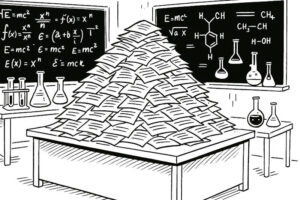Sometimes a paper comes out that has the seeds of a great idea that could lead to a whole new line of pioneering research. But, instead, nothing much happens, except imitative works that do not push the core idea forward at all.
For example the McCulloch Pitts paper from 1943 showed how neural networks could represent arbitrary logical or Boolean expressions of a certain class. The paper was well-received at the time, brilliantly executed by co-authors with diverse expertise in neuroscience, logic and computing. Had its signficance been fully grasped, this paper might have, at least notionally, formed a unifying conceptual bridge between the two nascent schools of connectionism and symbolic AI (one can at least hope). But instead, the heated conflict in viewpoints in the field has persisted, even to this day.
Another example is George Miller’s 7 +/- 2 paper. This famous result showed humans are able to hold only a small number of pieces of information in mind at the same time while reasoning. This paper was important not just for the specific result, but for the breakthrough in methodology using rigorous experimental noninvasive methods to discover how human thinking works—a topic we know so little about, even today. However, the followup papers by others, for the most part, only extended or expanded on the specific finding in very minor ways. [1] Thankfully, Miller’s approach did eventually gain influence in more subtle ways.
Of course it’s natural from the incentive structures of publishing that many papers would be primarily derivative rather than original. It’s not a bad thing that, when a pioneering paper comes out, others very quickly write rejoinder papers containing evaluations or minor tweaks of the original result. Not bad, but sometimes we miss the larger implications of the original result and get lost in the details.
Another challenge is stovepiping—we get stuck in our narrow swim lanes for our specific fields and camps of research. [2] We don’t see the broader implications, such as connections and commonalities across fields that could lead to fruitful new directions.
Thankfully, at least to some extent current research in AI shows some mix of both innovation and imitation. Inspired in part by the accelerationist mindset, many new papers appear every day, some with significant new findings and others that are more modest riffs on previous papers.
Notes
[1] Following this line of research on human thought processes could be worthwhile for various reasons. For example, some papers in linguistics state that Chomsky‘s vision for a universal grammar is misguided because the common patterns in human language are entirely explainable by the processing limitations of the human mind. But this claim is made with no justification or methodological rigor of any kind. If I claimed a CPU performs vector addition or atomic operations efficiently because of “the capabilities of the processor,” I would need to provide some supporting evidence, for example, documenting that the CPU has vector processing units or specialized hardware for atomics. The assertions about language structure being shaped by the human mental processing faculty is just an empty truism, unless supported by some amount of scientific rigor and free of the common fallacies of statistical reasoning.
[2] I recently read a paper in linguistics with apparent promise, but the paper totally misconstrued the relationship between Shannon entropy and Kolmogorov complexity. Sadly this paper passed review in a linguistic journal, but if it had had a mathematically inclined reviewer, the problem would have been caught and fixed.









